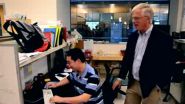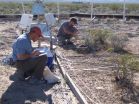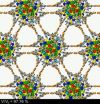(Press-News.org) LA JOLLA, CA—April 6, 2014—A study led by scientists at The Scripps Research Institute (TSRI) has helped solve a long-standing mystery about the sense of touch.
The "gentle touch" sensations that convey the stroke of a finger, the fine texture of something grasped and the light pressure of a breeze on the skin are brought to us by nerves that often terminate against special skin cells called Merkel cells. These skin cells' role in touch sensation has long been debated in the scientific community. The new study, however, suggests a dual-sensor system involving the Merkel cell and an associated nerve end in touch sensation.
"In this long debate over the role of Merkel cells, it appears that both camps were right," said the study's senior author Ardem Patapoutian, a Howard Hughes Medical Institute (HHMI) Investigator and professor at TSRI's Dorris Neuroscience Center and Department of Molecular & Cellular Neuroscience. "The nerve ends respond to touch, but so do the adjacent Merkel cells."
The report appears in an Advance Online Publication of Nature on April 6, 2014.
In addition to elucidating the mammalian sense of touch, whose mechanisms until recently have been obscure, the findings could have relevance for certain pain syndromes in which touch sensations trigger pain—even the light pressure of a shirt on the skin or a breeze against the skin.
"Touch and pain are very closely related," said Patapoutian, "and thus the characterization of these mechanisms of touch should help us to understand pain better too."
Opening the Flow
The discovery comes four years after the Patapoutian laboratory identified a protein called Piezo2 as a mechanically activated "ion channel" protein with a likely role in touch sensation.
Ion channels are embedded in the outer membranes of various cell types and nerve fibers throughout the body. Piezo2 ion channels have been thought to respond to the stretching of the nerve membrane where they are embedded—a stretching caused by something that presses against the skin, for example.
When activated in this way, the ion channels open to allow an inflow of sodium or other positively charged ions. Such a surge of electrical charge into a nerve can initiate a signal that travels up the nerve and to the brain via a relay of neurons along the spine.
In the earlier study, Patapoutian's team found evidence that Piezo2 proteins are made within touch-sensing neurons, including gentle-touch neurons that extend their nerves into the skin and against the mysterious Merkel cells.
In the new study, Patapoutian and his colleagues set out to learn more.
In Pursuit of Answers
The team began by creating a line of mice in which the activity of the Piezo2 gene also causes the production of a fluorescing protein called GFP. Guided by these fluorescent beacons as well as other markers, they found a high concentration of Piezo2 in Merkel cells in the skin of the mice.
"You can easily miss Piezo2 expression in the skin, because it's not highly expressed there, aside from the tiny population of Merkel cells," said first author Seung-Hyun Woo, a postdoctoral fellow in the Patapoutian laboratory.
Next the researchers sought proof of Piezo2's role in Merkel cells, essentially by subtracting the protein from those cells and observing the result. To do this—a particularly challenging feat—they created a new line of mice in which the Piezo2 gene is specifically "knocked out" of all skin cells, including Merkel cells, but left intact everywhere else where it is ordinarily produced.
Piezo2 skin-knockout mice and their Merkel cells appeared normal. The mice also responded normally on most standard tests of touch and pain sensitivity. But on the so-called von Frey test, in which thin, bendable fibers are pressed against the mice's paws with varying force, the effect of the loss of Piezo2 became apparent. "The mice whose Merkel cells lacked Piezo2 didn't respond to the gentler forces as much as the control mice did," said Woo.
Examining this change in responsiveness in more detail, Woo and her colleagues isolated Merkel cells from the two groups of mice. They found that those Merkel cells lacking Piezo2 failed to show the usual current flows when gently pushed with a probe.
Collaborating researchers in the laboratory of Cheryl L. Stucky at the Medical College of Wisconsin showed that gentle touch-sensing nerves known as slowly adapting (SA) Aβ fibers generally responded with a lower frequency of signaling in the mice lacking Piezo2 in Merkel cells. Another collaborating laboratory, led by Ellen A. Lumpkin at Columbia University, showed that Merkel cell-associated nerves also responded less durably to test stimuli on skin in these same mice.
"It all shows that the Merkel cells play an important role in touch sensing and that they need Piezo2 to do so," Woo said.
The findings were bolstered by a separate study from Lumpkin's laboratory—of which Patapoutian is a co-author—that is reported in the same issue of Nature. In that study, mice engineered to lack Merkel cells exhibited touch-sensing deficits very similar to those described in the Patapoutian group's study.
INFORMATION:
Other co-authors of the study, "Piezo2 is required for Merkel cell mechanotransduction," were Sanjeev Ranade, Adrienne E. Dubin and Takashi Miyamoto of TSRI during the study, Andy D. Weyer of the Stucky Laboratory at the Medical College of Wisconsin, Yoshichika Baba of the Lumpkin Laboratory and Zhaozhu Qiu, Matt Petrus and Kritika Reddy of the Genomics Institute of the Novartis Research Foundation.
The study was funded in part by the National Institutes of Health (grants R01DE022358 and R01AR051219).
Scripps Research Institute scientists provide new grasp of soft touch
2014-04-06
ELSE PRESS RELEASES FROM THIS DATE:
Amino acid fingerprints revealed in new study
2014-04-06
VIDEO:
This animation shows the basic process of sequencing amino acids in a nanopore, using the technique of recognition tunneling.
Click here for more information.
Some three billion base pairs make up the human genome—the floor plan of life. In 2003, the Human Genome Project announced the successful decryption of this code, a tour de force that continues to supply a stream of insights relevant to human health and disease.
Nevertheless, the primary actors in virtually all ...
Scientists find potential drug targets in deadly pediatric brain tumors
2014-04-06
BOSTON, MA (April 6, 2014) -- Researchers studying a rare, always fatal brain tumor in children have found several molecular alterations that drive the cancer, according to a new study from scientists at Dana-Farber/Boston Children's Cancer and Blood Disorders Center and McGill University. The findings identify potential new targets for drug treatments.
The new research could help physicians choose targeted agents with a better chance of combating pediatric high-grade astrocytomas, which are extremely difficult to treat with radiation and surgery. The tumors have resisted ...
Field study shows why food quality will suffer with rising CO2
2014-04-06
For the first time, a field test has demonstrated that elevated levels of carbon dioxide inhibit plants' assimilation of nitrate into proteins, indicating that the nutritional quality of food crops is at risk as climate change intensifies.
Findings from this wheat field-test study, led by a UC Davis plant scientist, will be reported online April 6 in the journal Nature Climate Change.
"Food quality is declining under the rising levels of atmospheric carbon dioxide that we are experiencing," said lead author Arnold Bloom, a professor in the Department of Plant Sciences.
"Several ...
Researchers find arid areas absorb unexpected amounts of atmospheric carbon
2014-04-06
PULLMAN, Wash.—Researchers led by a Washington State University biologist have found that arid areas, among the biggest ecosystems on the planet, take up an unexpectedly large amount of carbon as levels of carbon dioxide increase in the atmosphere. The findings give scientists a better handle on the earth's carbon budget—how much carbon remains in the atmosphere as CO2, contributing to global warming, and how much gets stored in the land or ocean in other carbon-containing forms.
"It has pointed out the importance of these arid ecosystems," said R. Dave Evans, a WSU professor ...
Friedreich's ataxia -- an effective gene therapy in an animal model
2014-04-06
The transfer, via a viral vector, of a normal copy of the gene deficient in patients, allowed to fully and very rapidly cure the heart disease in mice. These findings are published in Nature Medicine on 6 April, 2014.
Friedreich's ataxia is a severe, rare hereditary disorder which combines progressive neuro-degeneration, impaired heart function and an increased risk of diabetes. The condition affects one in every 50,000 birth. There is currently no effective treatment for this disease. In most cases, Friedreich's ataxia starts in adolescence with impaired balance and ...
Smoking visibility mapped for the first time
2014-04-06
The visibility of smoking in city streets has for the first time anywhere been mapped, in new research from the University of Otago, Wellington, New Zealand.
The research found that up to 116 smokers outside bars/cafés could be seen from any one location in the outdoor public areas of downtown Wellington (e.g. on a footpath). Of 2600 people observed in the outdoor areas of bars and cafés, 16% were smoking, with a higher proportion than this in evenings.
Data from observations across the downtown area were mapped by the researchers, producing a record of the street ...
Blood test could provide rapid, accurate method of detecting solid cancers
2014-04-06
STANFORD, Calif. — A blood sample could one day be enough to diagnose many types of solid cancers, or to monitor the amount of cancer in a patient's body and responses to treatment. Previous versions of the approach, which relies on monitoring levels of tumor DNA circulating in the blood, have required cumbersome and time-consuming steps to customize it to each patient or have not been sufficiently sensitive.
Now, researchers at the Stanford University School of Medicine have devised a way to quickly bring the technique to the clinic. Their approach, which should be broadly ...
Self-assembled superlattices create molecular machines with 'hinges' and 'gears'
2014-04-06
VIDEO:
This video shows the motion of nanoparticles in neighboring layers of the superlattice as pressure is applied.
Click here for more information.
A combined computational and experimental study of self-assembled silver-based structures known as superlattices has revealed an unusual and unexpected behavior: arrays of gear-like molecular-scale machines that rotate in unison when pressure is applied to them.
Computational and experimental studies show that the superlattice ...
Groundbreaking optical device could enhance optical information processing, computers
2014-04-06
At St. Paul's Cathedral in London, a section of the dome called the Whispering Gallery makes a whisper audible from the other side of the dome as a result of the way sound waves travel around the curved surface. Researchers at Washington University in St. Louis have used the same phenomenon to build an optical device that may lead to new and more powerful computers that run faster and cooler.
Lan Yang, PhD, associate professor of electrical and systems engineering, and her collaborators have developed an essential component of these new computers that would run on light. ...
Columbia scientists identify key cells in touch sensation
2014-04-06
VIDEO:
This video shows a Merkel cell responding to touch.
Click here for more information.
NEW YORK, NY, April 6, 2014 — In a study published in the April 6 online edition of the journal Nature, a team of Columbia University Medical Center researchers led by Ellen Lumpkin, PhD, associate professor of somatosensory biology, solve an age-old mystery of touch: how cells just beneath the skin surface enable us to feel fine details and textures.
Touch is the last frontier of ...








